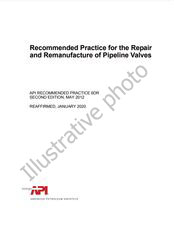We need your consent to use the individual data so that you can see information about your interests, among other things. Click "OK" to give your consent.

API MPMS 4.4-ed.2
Manual of Petroleum Measurement Standards Chapter 4—Proving Systems Section 4—Tank Provers
Translate name
STANDARD published on 1.12.2020
The information about the standard:
Designation standards: API MPMS 4.4-ed.2
Publication date standards: 1.12.2020
SKU: NS-1139606
The number of pages: 20
Approximate weight : 60 g (0.13 lbs)
Country: American technical standard
Category: Technical standards API
Annotation of standard text API MPMS 4.4-ed.2 :
API MPMS 4.4, 2nd Edition, May 1998 - Manual of Petroleum Measurement Standards Chapter 4—Proving Systems Section 4—Tank Provers
This chapter specifies the characteristics of stationary (fixed) or portable tank provers that are in general use and the procedures for their calibration. Guidelines are provided for the design, manufacture, calibration and use of new and/or replacement tank provers, and are not intended to make any existing tank provers obsolete.
More specific design criteria are available in NIST1 Handbook 105-3, Specifications and Tolerances for Graduated Neck-Type Volumetric Field Standards (includes Provers, per Section 1.1 of NIST 105-3). Consideration must also be given to the requirements of any weights and measures authority that may be involved.
1National Institute of Standards and Technology, Gaithersburg, Maryland 20899.
We recommend:
Technical standards updating
Do you want to make sure you use only the valid technical standards?
We can offer you a solution which will provide you a monthly overview concerning the updating of standards which you use.
Would you like to know more? Look at this page.



 Cookies
Cookies
